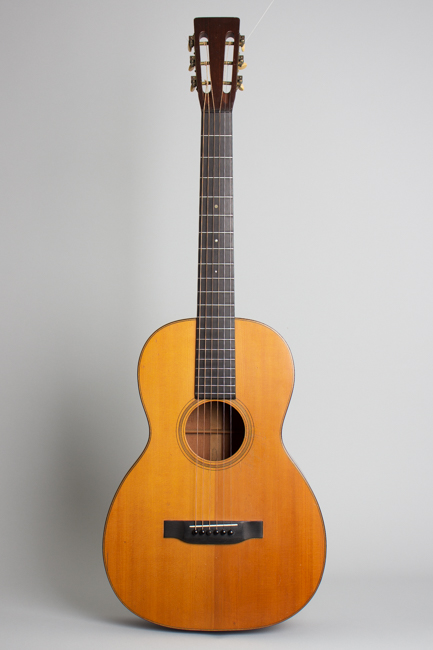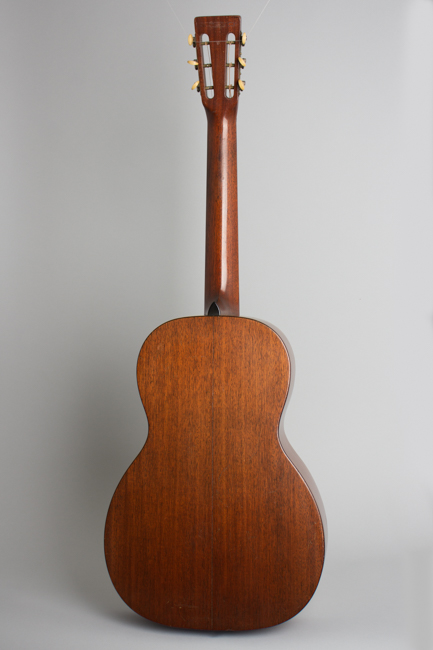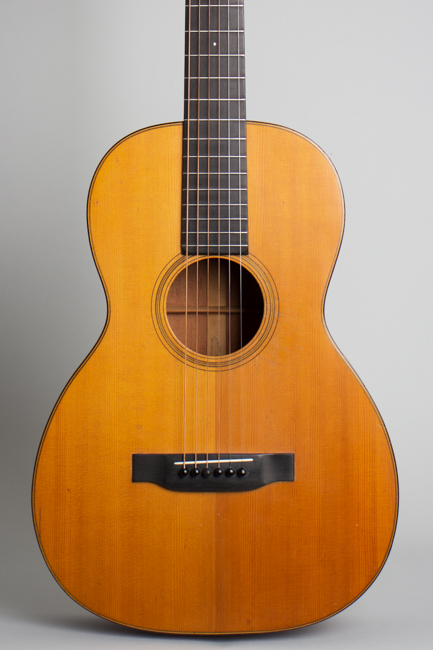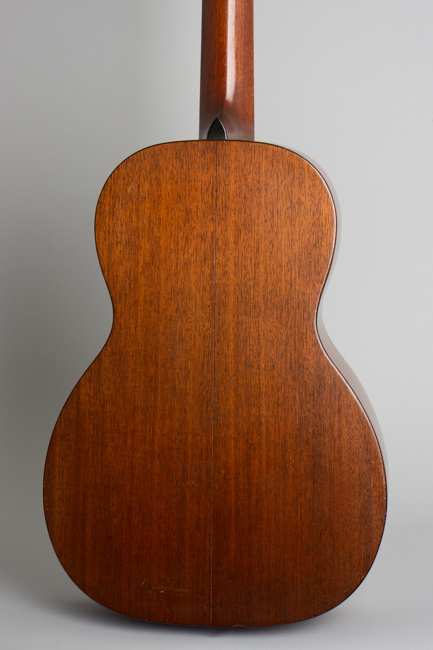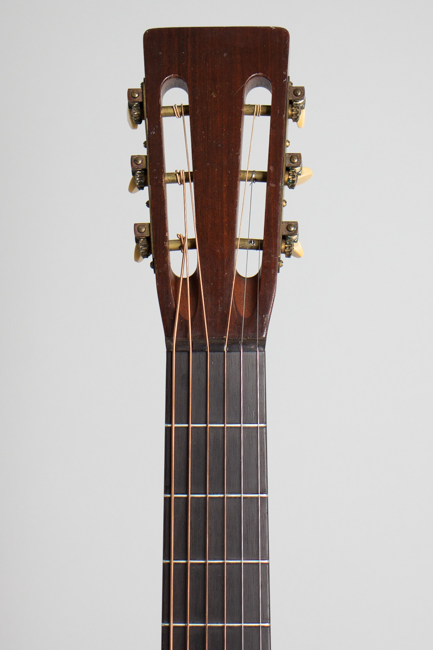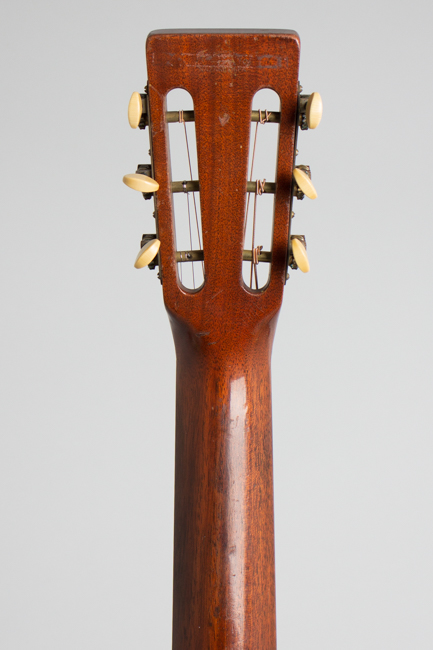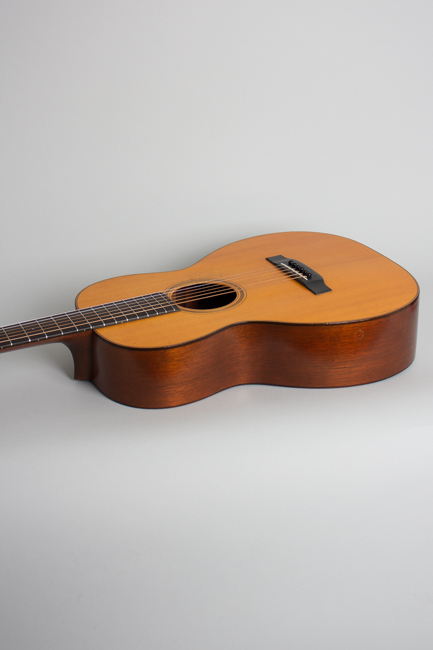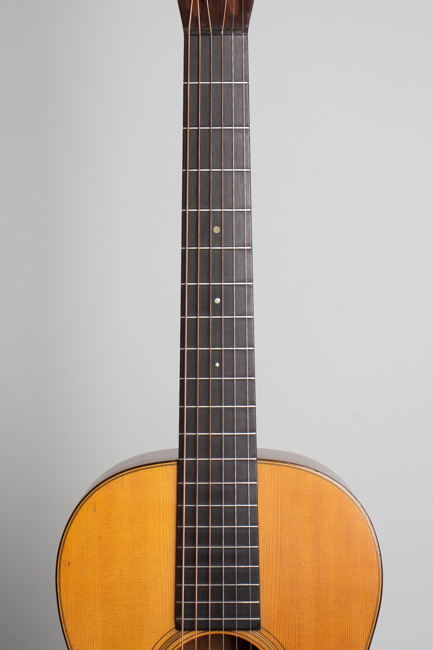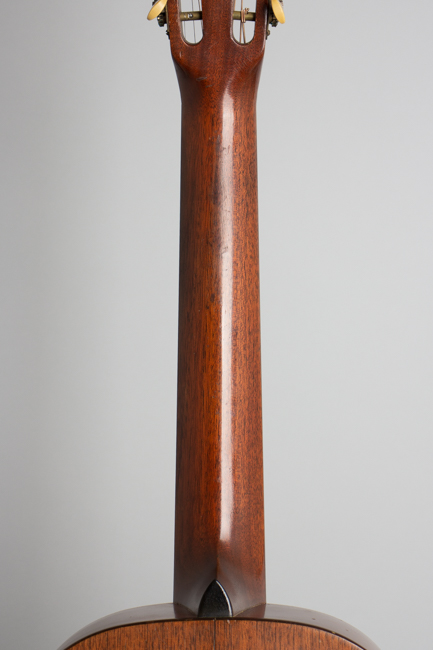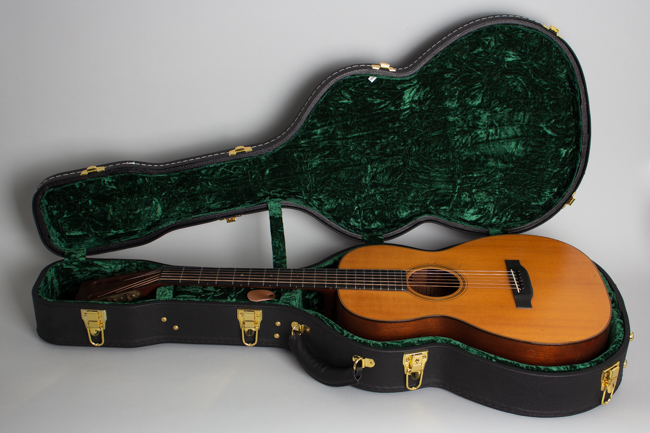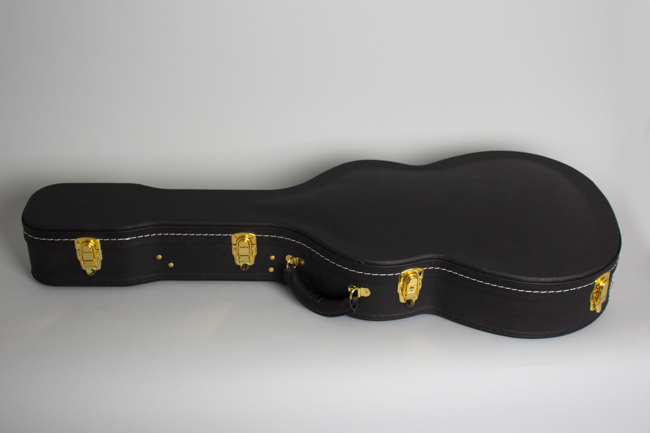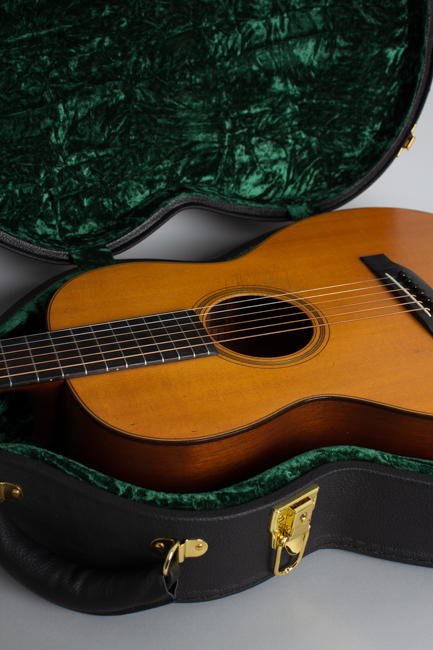C. F. Martin 00-18 Flat Top Acoustic Guitar (1930)
Item # 10419
Prices subject to change without notice.
C. F. Martin 00-18 Model Flat Top Acoustic Guitar (1930), made in Nazareth, PA, serial # 42821, natural lacquer finish, Adirondack spruce top, Honduras mahogany sides and neck, ebony fingerboard and bridge, rosewood bound top, black tolex hard shell case.
The 12-fret, steel string Martins of the late 1920s and very early 1930s are some of our very favorite guitars. For only a few years right at this time -- just before Martin altered nearly all their designs to the 14-fret neck "Orchestra Model" pattern -- the company crafted a relatively small number of these traditional long-body scallop-braced flat-tops braced for steel strings instead of the gut used previously.
The other features remained pretty much as they had been since the 19th century, with a wide ebony fingerboard on the neck which joins the body at the 12th fret. These guitars were the final evolution of the original 1800s Martin patterns before the "modern" 14-fret design became the standard just a few years later. This early 1930 guitar has the new-style larger ebony belly bridge, a feature which had just recently been added to this model.
The Style 18 designation signifies a fairly modest instrument, the 00-18 being the middle mahogany model in the company's line, between the smaller 0-18 and the 15" wide 000-18. These Style 18 models were built with mahogany back and sides instead of the even-at-the-time costly Brazilian rosewood but still maintain the same quality workmanship standards as the highest-grade instruments. The trim is simple with rosewood binding on the body, plain wood soundhole rings and small graduated dot inlay on the unbound ebony fingerboard. The tuners are simple unplated brass strip units with celluloid buttons.
This 00-18 was built early in 1930 and is one of a paltry 283 examples shipped that year, priced at $40.00 (without case). Although that seems like a bargain even calculated in period money, it still represented a lot of cash for many Americans just as the depression was kicking in. This late 12-fret 00-18 is a rare guitar by today's standards; 1930's Martins were made in very small numbers compared to later periods, and if the original price seems laughable today this was still a fairly expensive flat-top guitar for the time.
This Martin has had some typical wear and repair but is an excellent player remaining in more original condition than many period survivors. The sound is more powerful than one might expect for a smaller instrument and has surprising depth. It makes a great fingerstyle guitar, and also works very well with a flatpick, from stringband music to early jazz and beyond. It remains a testament to its builder's skill and reputation and at least as fine a mahogany 12-fret 00-sized model as anyone has ever made -- then or since.
Overall length is 38 1/8 in. (96.8 cm.), 14 1/8 in. (35.9 cm.) wide at lower bout, and 4 1/8 in. (10.5 cm.) in depth at side, taken at the end block. Scale length is 24 3/4 in. (629 mm.). Width of nut is 1 13/16 in. (46 mm.).
This guitar has had some re-working over the last 90+ years including but it remains a very solid player. The body and neck were lightly oversprayed, probably a long time ago. This finish shows fine checking throughout and spots of minor "orange peel" rippling, a result of the overspray. The top is not heavily worn but there are patches of strum wear around the soundhole, particularly around the area where Martin would shortly start putting a pickguard.
The bridge has been replaced with a replica ebony belly bridge slightly larger than the original pattern. This bridge has a drop-in saddle unlike the original through saddle; it has also been shaved down in profile. The top has one small repaired crack at the very edge of the lower bout on the bass side; that is the only crack damage to the spruce top.
There are several repaired rim cracks on the treble side lower bout. They were glued and the area was sanded down through the finish and then oversprayed, which is fairly evident on close examination. The bass side and the back are comparatively clean, with only some general scuffs and scratches and no cracks. The neck has some light wear, the headstock is free of any overspray. The Martin stamp on the back of the peghead is somewhat obscured by an area where something, most likely a name tag, was glued and later removed.
Internally the treble side rim cracks have been reinforced with black cloth. The original bridge plate is intact but has had a thin rectangular plate glued over the pin holes, presumably to reinforce string ballend wear in that area. The original bar frets have been dressed, but they play well and there is still plenty of life left in them. The fingerboard shows some divoting in the lower positions and the nut is a replica ebony piece. While not a perfectly original guitar this is still a fine playing end excellent sounding 00, a fine gigging example of this classic Martin creation. Overall Very Good + Condition.
The 12-fret, steel string Martins of the late 1920s and very early 1930s are some of our very favorite guitars. For only a few years right at this time -- just before Martin altered nearly all their designs to the 14-fret neck "Orchestra Model" pattern -- the company crafted a relatively small number of these traditional long-body scallop-braced flat-tops braced for steel strings instead of the gut used previously.
The other features remained pretty much as they had been since the 19th century, with a wide ebony fingerboard on the neck which joins the body at the 12th fret. These guitars were the final evolution of the original 1800s Martin patterns before the "modern" 14-fret design became the standard just a few years later. This early 1930 guitar has the new-style larger ebony belly bridge, a feature which had just recently been added to this model.
The Style 18 designation signifies a fairly modest instrument, the 00-18 being the middle mahogany model in the company's line, between the smaller 0-18 and the 15" wide 000-18. These Style 18 models were built with mahogany back and sides instead of the even-at-the-time costly Brazilian rosewood but still maintain the same quality workmanship standards as the highest-grade instruments. The trim is simple with rosewood binding on the body, plain wood soundhole rings and small graduated dot inlay on the unbound ebony fingerboard. The tuners are simple unplated brass strip units with celluloid buttons.
This 00-18 was built early in 1930 and is one of a paltry 283 examples shipped that year, priced at $40.00 (without case). Although that seems like a bargain even calculated in period money, it still represented a lot of cash for many Americans just as the depression was kicking in. This late 12-fret 00-18 is a rare guitar by today's standards; 1930's Martins were made in very small numbers compared to later periods, and if the original price seems laughable today this was still a fairly expensive flat-top guitar for the time.
This Martin has had some typical wear and repair but is an excellent player remaining in more original condition than many period survivors. The sound is more powerful than one might expect for a smaller instrument and has surprising depth. It makes a great fingerstyle guitar, and also works very well with a flatpick, from stringband music to early jazz and beyond. It remains a testament to its builder's skill and reputation and at least as fine a mahogany 12-fret 00-sized model as anyone has ever made -- then or since.
Overall length is 38 1/8 in. (96.8 cm.), 14 1/8 in. (35.9 cm.) wide at lower bout, and 4 1/8 in. (10.5 cm.) in depth at side, taken at the end block. Scale length is 24 3/4 in. (629 mm.). Width of nut is 1 13/16 in. (46 mm.).
This guitar has had some re-working over the last 90+ years including but it remains a very solid player. The body and neck were lightly oversprayed, probably a long time ago. This finish shows fine checking throughout and spots of minor "orange peel" rippling, a result of the overspray. The top is not heavily worn but there are patches of strum wear around the soundhole, particularly around the area where Martin would shortly start putting a pickguard.
The bridge has been replaced with a replica ebony belly bridge slightly larger than the original pattern. This bridge has a drop-in saddle unlike the original through saddle; it has also been shaved down in profile. The top has one small repaired crack at the very edge of the lower bout on the bass side; that is the only crack damage to the spruce top.
There are several repaired rim cracks on the treble side lower bout. They were glued and the area was sanded down through the finish and then oversprayed, which is fairly evident on close examination. The bass side and the back are comparatively clean, with only some general scuffs and scratches and no cracks. The neck has some light wear, the headstock is free of any overspray. The Martin stamp on the back of the peghead is somewhat obscured by an area where something, most likely a name tag, was glued and later removed.
Internally the treble side rim cracks have been reinforced with black cloth. The original bridge plate is intact but has had a thin rectangular plate glued over the pin holes, presumably to reinforce string ballend wear in that area. The original bar frets have been dressed, but they play well and there is still plenty of life left in them. The fingerboard shows some divoting in the lower positions and the nut is a replica ebony piece. While not a perfectly original guitar this is still a fine playing end excellent sounding 00, a fine gigging example of this classic Martin creation. Overall Very Good + Condition.
